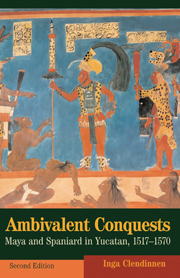Book contents
- Frontmatter
- Contents
- List of illustrations
- Preface to the second edition
- Preface to the first edition
- Acknowledgments
- Map I Yucatan in the conquest period
- Part I Spaniards
- 1 Explorers
- 2 Conquerors
- 3 Settlers
- 4 Missionaries
- 5 Conflict
- 6 Crisis
- 7 Attrition
- 8 Retrospections
- Epilogue: The hall of mirrors
- Part II Indians
- Epilogue: Confusion of tongues
- Appendix: A sampler of documents
- Glossary of Spanish and Maya terms
- Notes
- Select bibliography
- Index
6 - Crisis
Published online by Cambridge University Press: 05 October 2013
- Frontmatter
- Contents
- List of illustrations
- Preface to the second edition
- Preface to the first edition
- Acknowledgments
- Map I Yucatan in the conquest period
- Part I Spaniards
- 1 Explorers
- 2 Conquerors
- 3 Settlers
- 4 Missionaries
- 5 Conflict
- 6 Crisis
- 7 Attrition
- 8 Retrospections
- Epilogue: The hall of mirrors
- Part II Indians
- Epilogue: Confusion of tongues
- Appendix: A sampler of documents
- Glossary of Spanish and Maya terms
- Notes
- Select bibliography
- Index
Summary
1562 must have been something of a watershed year for the Yucatan Franciscans, a time for reviewing what were, on any score, formidable achievements. The worst excesses of the colonists had been curbed, and through the reduction of Hernández they had been taught a useful lesson as to the respect due to the Order. With the appointment of Quijada, the first resident ‘outsider’ – the judge-inspectors had been birds of passage – local control over the apparatus of the royal administration had been broken. Quijada himself was or could be made properly respectful of ecclesiastical authority. The first bishop was to be a Franciscan, and a Franciscan of impeccable credentials, seasoned in the field. And the mission – given the difficult terrain, given limited manpower, given the mere seventeen years of its existence – was thriving.
There was still only a handful of secular clergy in the province, but the population of friars had grown. Bienvenida had been twice to Spain, bringing back recruits each time. Just how many Franciscans there were in the peninsula at any time after the earliest days is uncertain, as the records have been lost, but the original eight had been joined by perhaps nine in 1549, fifteen in 1533, and ten or eleven in 1561. Death and disability must have claimed some: the sapping work and sapping heat of Yucatan took its toll. Some left: there was more movement of men between Mexico, Yucatan and Guatemala than the rigours of travel would lead us to expect.
- Type
- Chapter
- Information
- Ambivalent ConquestsMaya and Spaniard in Yucatan, 1517–1570, pp. 72 - 92Publisher: Cambridge University PressPrint publication year: 2003

